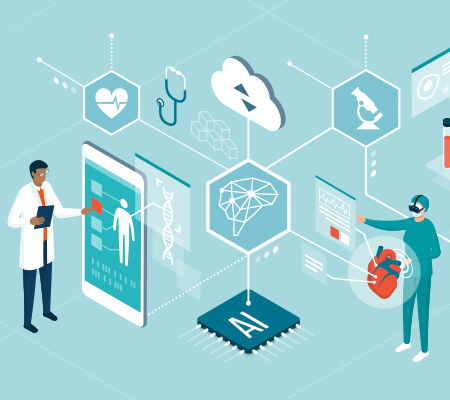
When you think of artificial intelligence, you probably think of the robots and computers of the future. However, scientists are using artificial intelligence right now in health care.
When you think of artificial intelligence, you probably think of the robots and computers of the future. However, scientists are using artificial intelligence right now in health care.
Artificial intelligence, commonly referred to as AI, is a set of computational techniques that help computers complete tasks without hard code. These computational techniques almost let the computer think for itself to complete certain tasks.
The computers learn using algorithms and hard data. As an example, imagine you had thousands of images of birds. If you then showed those images to the computer and told the computer where the bird was in the picture, an algorithm can be used to find the birds in the picture without a human. The algorithm is able to pick up on clues, such as a beak or feathers that suggest the animal is a bird.
“In recent developments, scientist are using AI for different tasks in health care including diagnosing cancer and studying patterns in electronic health records,” said John Mayer, Ph.D., research programmer analyst senior with the Office of Research Computing and Analytics at Marshfield Clinic Research Institute. “AI has the potential to use data to detect conditions in patients sooner and, in some cases, more effectively than humans.”
Breast cancer detection
Using artificial intelligence to detect breast cancer is one of the areas developed the furthest. In general, the tools use a mammogram image to detect breast cancer similar to how a radiologist can.
“There are research articles that show this technique improves diagnosis of breast cancer,” Mayer said. “It is in the preliminary stage, but we can expect to make use of artificial intelligence and assist radiologists in detection of breast cancer in the near future.”
This same type of tool can be created for many different applications including diagnosing neurological diseases, identifying cardiovascular abnormalities and detecting fractures and musculoskeletal injuries.
Finding health concerns in a large dataset
The other primary use for artificial intelligence is using algorithms to study patterns in electronic health records and genetics. Electronic health records are stored for every person that goes to a doctor. If you bring together a large dataset of electronic health records or genetic information, you can develop an algorithm that can find common themes among the patients in the data.
For example, you can use an algorithm to find prescriptions that work well for certain health conditions in certain people. This use of artificial intelligence in this way is often referred to as precision medicine.
The drawbacks
While there are many potential benefits of AI, there also are drawbacks.
In order to learn from data, the computer requires a very large set of very accurate data and computational resources to run the algorithm. This means you need to have a lot of computer power and a lot of data in one location, which can be really expensive.
Getting the diagnosis wrong also is a concern when using AI. Additionally, there are many regulations that need to be determined including who is responsible if a mistake is made.
“At this time, researchers are not thinking of replacing doctors with AI. AI would be a second opinion to help catch errors. So some of these concerns are distant,” Mayer said. “AI is a tool that, if used properly, can help us in our tasks – make us more accurate, faster and more reliable. The ultimate goal of AI in health care is to provide better care with lower costs.”

